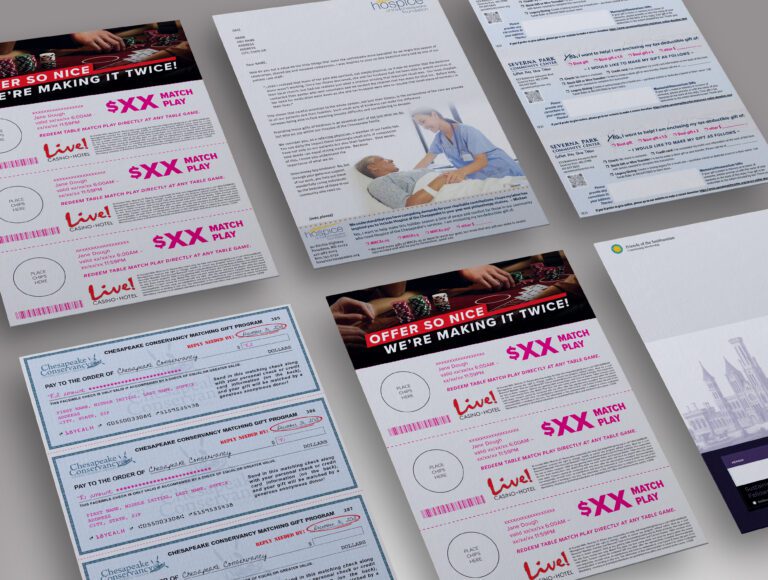How to Personalize Direct Mail Using Variable Data and Images

Direct mail has evolved far beyond its early days of mass distribution. Today, personalization is at the heart of direct mail’s resurgence as a powerful marketing tool. By leveraging variable data and images, companies can deliver highly customized mail pieces that resonate with their audience on an individual level.
In this article, we’ll explore how businesses can use variable data and images in their direct mail campaigns to enhance customer engagement and provide a hypothetical case study that demonstrates these strategies in action. We’ll also include key questions to help you reflect on your own direct mail practices.
What is Variable Data?
Variable data printing (VDP) allows marketers to change specific elements of a direct mail piece for each recipient, based on information from a database. This customization can include personalized names, addresses, purchase histories, and preferences.
For example, rather than sending a one-size-fits-all postcard, you can tailor each piece to feature unique messages or offers relevant to the recipient’s past interactions with your brand. Personalization fosters deeper connections with customers, as it reflects an understanding of their individual needs and preferences.
Ask Yourself:
– How effectively are you currently using customer data in your direct mail campaigns?
– Are there additional data points you could leverage (e.g., purchase history, location, or preferences) to improve your messaging?
How Variable Images Work
The power of personalization extends beyond just text. Variable images allow marketers to swap out pictures and visuals within a mailer based on the recipient’s interests or demographics. Imagine you run a home improvement business: your customers in colder climates might receive an image of a snowblower, while customers in warmer regions receive images of lawn care tools.
By aligning visuals with the recipient’s profile, you create a more engaging and relevant experience—one that captures attention more effectively than a generic, one-size-fits-all design.
Reflect On:
– Are you currently using visuals tailored to your audience segments?
– How could personalized imagery improve the relevance and engagement of your mailers?
Why Personalization is Key
Personalized direct mail campaigns consistently outperform non-personalized efforts. According to recent statistics, the response rate for direct mail is between 4.9% and 9%, depending on the audience (household or prospect), compared to only 0.6% for email marketing. Additionally, studies show that 73% of American consumers prefer direct mail for brand communication because it feels more personal.
When businesses incorporate variable data and images, the mail piece becomes a tailored experience—more than just a piece of paper. It shows that the business is paying attention to the individual, making the recipient feel valued. This can result in higher engagement rates, better brand loyalty, and, ultimately, stronger returns on investment.
Best Practices for Variable Data and Image Integration
1. Audience Segmentation:
Start by segmenting your customer database. Group recipients based on demographics, past purchase behavior, or geographic location. This segmentation will guide the variable elements in your mailer.
2. Data Accuracy:
Clean and accurate data is the backbone of any personalized campaign. Ensure your customer data is up to date to avoid mistakes that can undermine trust, such as incorrect names or irrelevant product recommendations.
3. Flexible Design Templates:
Your design should accommodate various pieces of data and images without sacrificing aesthetics. Use templates that are flexible enough to adapt to different content while maintaining a cohesive look. For more information on how to design, check out our blog Mastering Direct Mail Design
4. Testing and Refining:
Test your campaign with a small group before sending it out to your entire audience. A/B testing different levels of personalization can help identify which variables (text, images, offers) drive the best response rates.
Self-Evaluate:
– When was the last time you cleaned and updated your customer data?
– Could your audience segmentation be more precise to allow for even better targeting in your campaigns?
—
Hypothetical Case Study: Outdoor Gear Co.
Let’s consider a fictional business—Outdoor Gear Co.—that sells equipment for various outdoor activities. Their goal is to improve the response rate of their direct mail campaigns by incorporating personalized elements.
The Problem:
Outdoor Gear Co. had been sending out generic catalogs to their customer base, showcasing a wide range of products. However, their response rate was low. They realized that their customers had highly diverse interests—some preferred hiking, others water sports, and still others were into winter gear. The generic mailers didn’t resonate with their audience, leaving customers disengaged.
The Solution:
Outdoor Gear Co. decided to implement variable data and images in their next direct mail campaign. Here’s how they did it:
– Segmentation: The company divided its customer base into three groups: hikers, water sports enthusiasts, and winter sports fans. They used purchase history and past engagement data to create these segments.
– Variable Data and Images: Each customer received a postcard addressed to them by name, with a personalized message that reflected their specific interests. For example, the hiking segment received messaging about new trail shoes and backpacks, while the winter sports group learned about new snowboards and insulated jackets. Custom imagery relevant to each segment was used to reinforce the personalized message.
The Results:
The personalized approach resulted in a 35% increase in response rates compared to previous, generic campaigns. Customers felt more connected to the brand, and many commented on the relevancy of the offers they received. Additionally, Outdoor Gear Co. saw a notable increase in website traffic and in-store visits following the campaign.
—
Conclusion
Personalization in direct mail isn’t just a nice-to-have—it’s a must for businesses looking to stand out. By using variable data and images, businesses can create a unique and relevant experience for each recipient, increasing the chances that your mail gets noticed, opened, and acted upon.
As demonstrated by our hypothetical case study, leveraging these tools can drive better engagement, deliver stronger returns, and position your business as a leader in personalized marketing.




